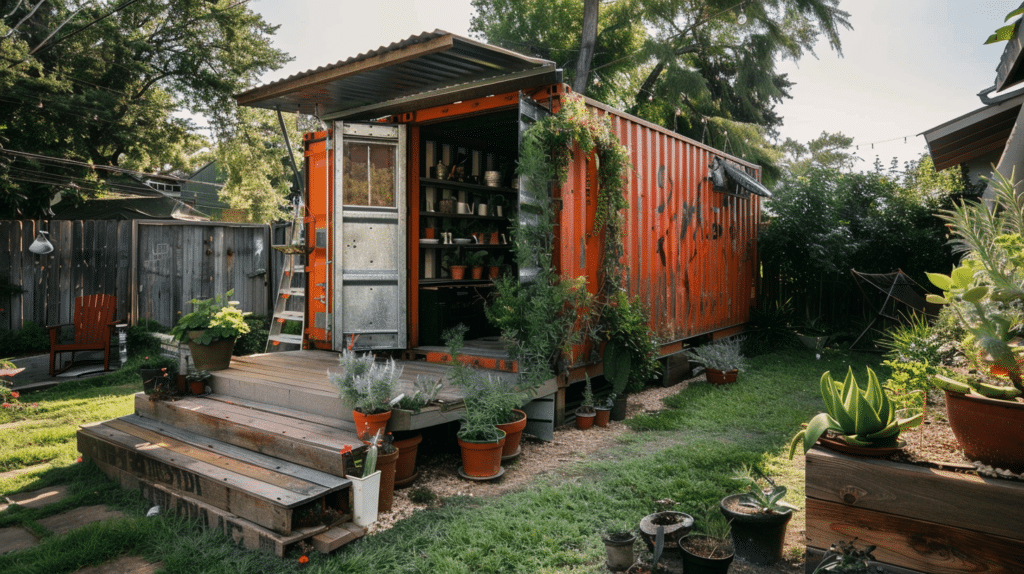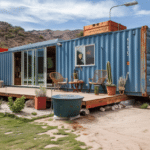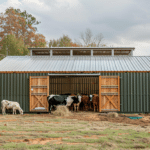Table of Contents
ToggleThe Versatility of Shipping Containers: Using Them as Sheds
In recent years, shipping containers have gained popularity for their versatility in construction projects beyond their traditional use. One of the innovative ways these containers are being repurposed is as sheds. Whether it’s for residential, commercial, or industrial purposes, converting shipping containers into sheds offers numerous benefits. This article explores why using shipping containers for sheds is a practical choice, compares them with traditional metal and wooden sheds, discusses the best options, sheds light on various types available, highlights their benefits, and provides essential considerations and tips for making the most of container shed investments.
Why Use Shipping Containers For Sheds
- Durability: Shipping containers are built to withstand harsh marine environments, making them inherently durable and weather-resistant. They can withstand extreme temperatures, heavy winds, and even seismic activity, ensuring longevity.
- Mobility: As containers are designed for transportation, they are inherently portable. This mobility allows for flexibility in placement and relocation of the shed as needed, providing convenience and adaptability.
- Cost-effectiveness: Compared to traditional construction materials, such as wood or brick, shipping containers offer a more economical option. Their sturdy structure and ease of modification can result in lower construction costs.
- Environmentally Friendly: Repurposing shipping containers reduces waste by giving them a second life. It also reduces the need for new construction materials, making it an eco-friendly choice for environmentally conscious individuals and businesses.
Shipping Container Shed vs. Metal Shed vs. Wooden Storage Shed – Which Option is Best
- Metal Shed: Metal sheds are durable and low-maintenance, but they may lack the aesthetic appeal of wooden sheds and can be prone to rust over time.
- Wooden Storage Shed: Wooden sheds offer a classic, natural look and can be easily customized. However, they require regular maintenance to prevent rot, insect damage, and decay.
- Shipping Container Shed: Shipping container sheds combine the durability of metal with the versatility of wood. They offer superior strength, require minimal maintenance, and provide a unique aesthetic appeal.
What’s the Best Option
The best option ultimately depends on individual preferences, budget, and intended use. Shipping container sheds are ideal for those seeking durability, versatility, and a modern aesthetic. They offer a balance between the ruggedness of metal sheds and the customizability of wooden sheds.
Types of Sheds
Shipping container sheds come in various sizes and configurations to suit different needs:
- Standard Shed: A single shipping container is used as a standalone shed for storage or as a workshop.
- Multi-container Shed: Multiple containers are combined to create a larger shed with multiple rooms or compartments.
- Modified Shed: Containers are modified with additional doors, windows, insulation, and electrical wiring to accommodate specific requirements.
Benefits of Using Shipping Containers as Sheds
- Strength and Durability: Shipping containers are made of corrosion-resistant steel, providing unparalleled strength and durability.
- Security: With sturdy locking mechanisms and steel construction, container sheds offer excellent security for storing valuable items and equipment.
- Customization: Containers can be easily modified to include features like windows, doors, shelving, and insulation, allowing for customization according to individual needs.
- Quick Installation: Compared to traditional construction methods, container sheds can be installed relatively quickly, saving time and labor costs.
- Versatility: Container sheds can serve a wide range of purposes, from simple storage solutions to workshops, offices, or even living spaces.
Things to Consider Before Investing in a Container Shed
- Local Regulations: Check local zoning laws and building codes to ensure compliance before installing a container shed.
- Site Preparation: Proper site preparation is essential to ensure a stable foundation and adequate drainage for the shed.
- Insulation and Ventilation: Depending on the climate and intended use, consider insulation and ventilation options to regulate temperature and moisture levels inside the shed.
- Budget: Determine a realistic budget for purchasing, modifying, and installing the container shed, including any additional costs for site preparation and customization.
Tips for Using Space Optimally
- Vertical Storage: Utilize vertical space by installing shelves, racks, or hanging storage solutions to maximize storage capacity.
- Modular Furniture: Choose modular furniture and storage solutions that can be easily rearranged to accommodate changing needs.
- Organization: Implement an organizational system to keep tools, equipment, and other items neatly arranged and easily accessible.
- Multipurpose Design: Consider multipurpose design elements, such as fold-down workbenches or convertible storage units, to maximize functionality in limited space.
Different Uses for Sheds
Sheds are versatile structures that can serve a variety of purposes, catering to both residential and commercial needs. Their flexibility in design and construction allows for customization to meet specific requirements. Here are several different uses for sheds:
- Storage: Perhaps the most common use for sheds is storage. They provide a convenient space to store tools, gardening equipment, outdoor furniture, seasonal decorations, sports gear, and other items that may clutter the home or garage. Sheds can range from small units for basic storage to larger structures with shelving, racks, and organizational systems for maximizing storage capacity.
- Workshop: Sheds make excellent workshops for DIY enthusiasts, hobbyists, artists, and craftsmen. A well-equipped shed can serve as a dedicated workspace for woodworking, metalworking, painting, crafting, or any other creative pursuits. Workshops may include workbenches, tool storage, power outlets, lighting, and ventilation systems to support various activities.
- Garden Shed: Gardeners often use sheds to store gardening tools, supplies, pots, and equipment. A garden shed can also serve as a potting shed, providing a space for planting, repotting, and nurturing seedlings. Some garden sheds include features like workbenches, sink units, shelves for organizing seeds and fertilizers, and hooks for hanging gardening tools.
- Home Office: With the rise of remote work and freelance careers, many people are converting sheds into home offices. A shed office offers a quiet, separate space away from the distractions of the main house, providing a conducive environment for productivity and focus. Shed offices can be customized with desks, chairs, storage cabinets, internet connectivity, heating, and cooling systems to create a comfortable workspace.
- Studio: Artists, musicians, writers, and photographers often use sheds as studios to pursue their creative endeavors. A studio shed provides a private, inspiring space for artistic expression and experimentation. Features such as ample natural light, soundproofing, ventilation, and storage for art supplies or musical instruments contribute to an optimal studio environment.
- Playhouse: Sheds can be transformed into playhouses or recreational spaces for children. These play sheds offer a safe, imaginative retreat where kids can engage in creative play, games, and activities. Playhouses may include features like windows, doors, seating areas, chalkboards, play kitchens, and storage for toys.
- Guest Accommodation: For homeowners needing additional guest accommodation, sheds can be converted into cozy guesthouses or cabins. These shed accommodations provide a private retreat for visitors, offering basic amenities such as a bed, seating area, lighting, and heating. With proper insulation and ventilation, shed guesthouses can be comfortable year-round.
- Entertainment Room: Sheds can serve as entertainment rooms for hosting gatherings, parties, or movie nights. Equipped with seating, audiovisual equipment, gaming consoles, and a mini bar, an entertainment shed provides a fun and inviting space for socializing and relaxation.
- Fitness Center: Fitness enthusiasts may opt to convert sheds into home gyms or exercise studios. A shed gym can accommodate workout equipment such as treadmills, weights, yoga mats, and stationary bikes, allowing individuals to pursue their fitness goals in the comfort and convenience of their own backyard.
- Animal Shelter: Sheds can be repurposed as shelters for pets or livestock. Whether it’s a doghouse, chicken coop, rabbit hutch, or horse stable, shed shelters provide protection from the elements and a safe, comfortable living space for animals.
These are just a few examples of the diverse uses for sheds. With creativity, imagination, and careful planning, sheds can be tailored to meet a wide range of needs, adding value and functionality to residential and commercial properties alike.
Additional Factors to Consider
- Maintenance: While shipping container sheds require minimal maintenance compared to wooden sheds, regular inspection and occasional repainting may be necessary to prevent corrosion.
- Transportation: If the shed needs to be relocated in the future, consider transportation logistics and any associated costs.
- Accessories: Factor in the cost of accessories such as lighting, security cameras, and climate control systems to enhance functionality and comfort.
Using shipping containers as sheds offers numerous advantages in terms of durability, versatility, cost-effectiveness, and sustainability. By carefully considering factors such as local regulations, site preparation, customization options, and space optimization, individuals and businesses can make the most of their container shed investments, enjoying a practical and efficient storage solution for years to come.






